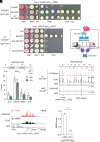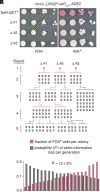Minimal requirements for the epigenetic inheritance of engineered silent chromatin domains
- PMID: 38198529
- PMCID: PMC10801849
- DOI: 10.1073/pnas.2318455121
Minimal requirements for the epigenetic inheritance of engineered silent chromatin domains
Abstract
Mechanisms enabling genetically identical cells to differentially regulate gene expression are complex and central to organismal development and evolution. While gene silencing pathways involving DNA sequence-specific recruitment of histone-modifying enzymes are prevalent in nature, examples of sequence-independent heritable gene silencing are scarce. Studies of the fission yeast Schizosaccharomyces pombe indicate that sequence-independent propagation of heterochromatin can occur but requires numerous multisubunit protein complexes and their diverse activities. Such complexity has so far precluded a coherent articulation of the minimal requirements for heritable gene silencing by conventional in vitro reconstitution approaches. Here, we take an unconventional approach to defining these requirements by engineering sequence-independent silent chromatin inheritance in budding yeast Saccharomyces cerevisiae cells. The mechanism conferring memory upon these cells is remarkably simple and requires only two proteins, one that recognizes histone H3 lysine 9 methylation (H3K9me) and catalyzes the deacetylation of histone H4 lysine 16 (H4K16), and another that recognizes deacetylated H4K16 and catalyzes H3K9me. Together, these bilingual "read-write" proteins form an interdependent positive feedback loop that is sufficient for the transmission of DNA sequence-independent silent information over multiple generations.
Keywords: HP1; SIR complex; epigenetic inheritance; heterochromatin; histone deacetylation.
Conflict of interest statement
Competing interests statement:The authors declare no competing interest.
Figures




Similar articles
-
Histone deacetylation primes self-propagation of heterochromatin domains to promote epigenetic inheritance.Nat Struct Mol Biol. 2022 Sep;29(9):898-909. doi: 10.1038/s41594-022-00830-7. Epub 2022 Sep 5. Nat Struct Mol Biol. 2022. PMID: 36064597 Free PMC article.
-
The molecular basis of heterochromatin assembly and epigenetic inheritance.Mol Cell. 2023 Jun 1;83(11):1767-1785. doi: 10.1016/j.molcel.2023.04.020. Epub 2023 May 18. Mol Cell. 2023. PMID: 37207657 Free PMC article. Review.
-
Spreading and epigenetic inheritance of heterochromatin require a critical density of histone H3 lysine 9 tri-methylation.Proc Natl Acad Sci U S A. 2021 Jun 1;118(22):e2100699118. doi: 10.1073/pnas.2100699118. Proc Natl Acad Sci U S A. 2021. PMID: 34035174 Free PMC article.
-
Centromere silencing and function in fission yeast is governed by the amino terminus of histone H3.Curr Biol. 2003 Oct 14;13(20):1748-57. doi: 10.1016/j.cub.2003.09.031. Curr Biol. 2003. PMID: 14561399
-
The Nuts and Bolts of Transcriptionally Silent Chromatin in Saccharomyces cerevisiae.Genetics. 2016 Aug;203(4):1563-99. doi: 10.1534/genetics.112.145243. Genetics. 2016. PMID: 27516616 Free PMC article. Review.
Cited by
-
Inheritance of H3K9 methylation regulates genome architecture in Drosophila early embryos.EMBO J. 2024 Jul;43(13):2685-2714. doi: 10.1038/s44318-024-00127-z. Epub 2024 Jun 3. EMBO J. 2024. PMID: 38831123 Free PMC article.
-
The epigenetic circle: feedback loops in the maintenance of cellular memory.Epigenetics Chromatin. 2025 Aug 20;18(1):56. doi: 10.1186/s13072-025-00621-6. Epigenetics Chromatin. 2025. PMID: 40830515 Free PMC article. Review.
References
MeSH terms
Substances
Grants and funding
LinkOut - more resources
Full Text Sources
Molecular Biology Databases

